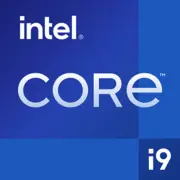Intel Core i9-9920X

Intel Core i9-9920X in 2025: Is It Worth Getting a Legend from the Past?
A complete breakdown of the processor for professionals and enthusiasts
Key Specifications: Architecture and Performance
The Intel Core i9-9920X processor, released in 2018, still attracts attention due to its unique combination of specifications. It is built on the Skylake-X microarchitecture with a 14 nm process technology—by modern standards, this is outdated, but it provided high performance for its time.
- Cores and Threads: 12 cores and 24 threads.
- Frequencies: Base frequency — 3.5 GHz, maximum in turbo mode — 4.4 GHz (Turbo Boost Max 3.0).
- Cache: 19 MB L3.
- TDP: 165 W — a high thermal design power requiring serious cooling.
- Benchmarks: In Geekbench 6, the processor scores 1389 points in single-core and 3027 points in multi-core mode. In comparison, the modern Ryzen 9 7900X (2023) scores around ~2200 and ~18000 points respectively.
Key Features:
- Support for PCIe 3.0 (up to 44 lanes).
- Hyper-Threading and Intel Optane Memory technologies.
- Overclocking capability (with X299 chipsets supporting overclocking).
Compatible Motherboards: Socket and Chipsets
The processor uses the LGA 2066 socket, which is only compatible with motherboards on the Intel X299 chipset. In 2025, new boards for this socket are no longer being produced, but you can still find models on the secondary market or as leftover stock:
- ASUS ROG Rampage VI Extreme: Flagship board with advanced VRM and support for quad-channel memory (price in 2025: ~$300-400 for new, if available).
- MSI X299 Gaming Pro Carbon AC: Budget option with Wi-Fi and RGB lighting (~$250).
- Gigabyte X299 AORUS Ultra Gaming: Optimal balance of price and functionality (~$280).
Selection Tips:
- Ensure the board supports quad-channel memory for maximum performance.
- Check for M.2 slots for NVMe drives (PCIe 3.0 x4).
- For overclocking, choose models with a powerful power system (at least 8-phase VRM).
Supported Memory: DDR4 and Its Potential
The i9-9920X only works with DDR4, which in 2025 looks outdated against DDR5. However, the quad-channel mode helps compensate for the lag in bandwidth.
- Frequencies: Official support up to 2666 MHz, but most boards can overclock modules to 3200-3600 MHz.
- Capacity: Up to 128 GB (8 slots × 16 GB).
- Recommendations: DDR4-3200 CL16 kits (e.g., Corsair Vengeance LPX or G.Skill Trident Z) are the optimal choice for a balance of price and performance.
Power Supply: How Many Watts Do You Need?
With a TDP of 165 W and sensitivity to voltage stability, the i9-9920X requires a quality PSU:
- Minimum: 650 W (for systems without a discrete GPU).
- Recommended option: 750-850 W (if using a GPU like the NVIDIA RTX 4070 or AMD RX 7800 XT).
- Criteria: 80+ Gold or Platinum certification, modular cables. Examples:
- Corsair RM850x (~$130);
- Seasonic Focus GX-750 (~$110).
Important! When overclocking the processor and graphics card, plan for a power reserve of 20-30%.
Pros and Cons of the Core i9-9920X in 2025
Advantages:
1. Multi-threaded Performance: 24 threads are relevant for rendering, encoding, and virtualization.
2. Overclocking Potential: With good cooling, you can push it up to 4.7 GHz on all cores.
3. Cost: New processors (if any are left) are about $400-500, which is cheaper than modern 12-core CPUs.
Disadvantages:
1. Power Consumption: 165 W compared to 105-120 W for modern counterparts.
2. Outdated Technologies: No PCIe 4.0/5.0, DDR5, or USB4.
3. Limited Gaming Performance: In games, it lags behind even budget Ryzen 5 7600 due to low IPC (Instructions Per Cycle).
Use Cases: Who Is It Suitable For?
1. Professional Tasks:
- 3D rendering in Blender, Cinema 4D.
- Video editing in DaVinci Resolve (when using a GPU).
- Code compilation and virtualization (VMware, Docker).
2. Multimedia: Photo processing in Lightroom, live streaming.
3. Gaming: Only for older projects or paired with a powerful GPU at 4K resolution (where the load shifts to the graphics card).
Practical Example: A user on the Overclockers.ru forum built a PC on the i9-9920X for rendering in Keyshot—a scene rendering of 10 million polygons took 14 minutes compared to 18 minutes with a Ryzen 9 5900X.
Comparison with Competitors
1. AMD Ryzen 9 5900X (12 cores):
- Pros: PCIe 4.0, DDR4-3200, TDP 105 W.
- Cons: No quad-channel memory.
- Price: ~$350 (new).
2. Intel Core i7-14700K (20 cores):
- Pros: New Raptor Lake cores, DDR5, PCIe 5.0.
- Cons: Higher price (~$450).
Conclusion: The i9-9920X only wins in scenarios critical to memory bandwidth (quad-channel mode).
Practical Assembly Tips
1. Cooling:
- Cooler: Noctua NH-D15 or Arctic Liquid Freezer II 360 (for overclocking).
- Thermal paste: Thermal Grizzly Kryonaut.
2. Case: Choose models with good ventilation (e.g., Fractal Design Meshify 2).
3. BIOS: Update motherboard firmware for compatibility with new SSDs and peripherals.
4. Storage: Use NVMe SSDs (Samsung 980 Pro) to reduce bottlenecks.
Final Verdict: Who Should Get the i9-9920X in 2025?
This processor is suitable for:
- Professionals on a budget who need 12 cores for work tasks.
- Enthusiasts building a PC based on X299 for overclocking experiments.
- Owners of older systems looking for an upgrade without replacing the motherboard.
Avoid the i9-9920X if:
- Modern standards (DDR5, PCIe 5.0) are required.
- The main focus is on gaming.
- A low noise level and energy consumption are important.
In 2025, this CPU is a niche solution, but for certain tasks, it remains a workhorse.
Basic
CPU Specifications
Memory Specifications
GPU Specifications
Miscellaneous
Benchmarks
Compared to Other CPU
Share in social media
Or Link To Us
<a href="https://cputronic.com/cpu/intel-core-i9-9920x" target="_blank">Intel Core i9-9920X</a>